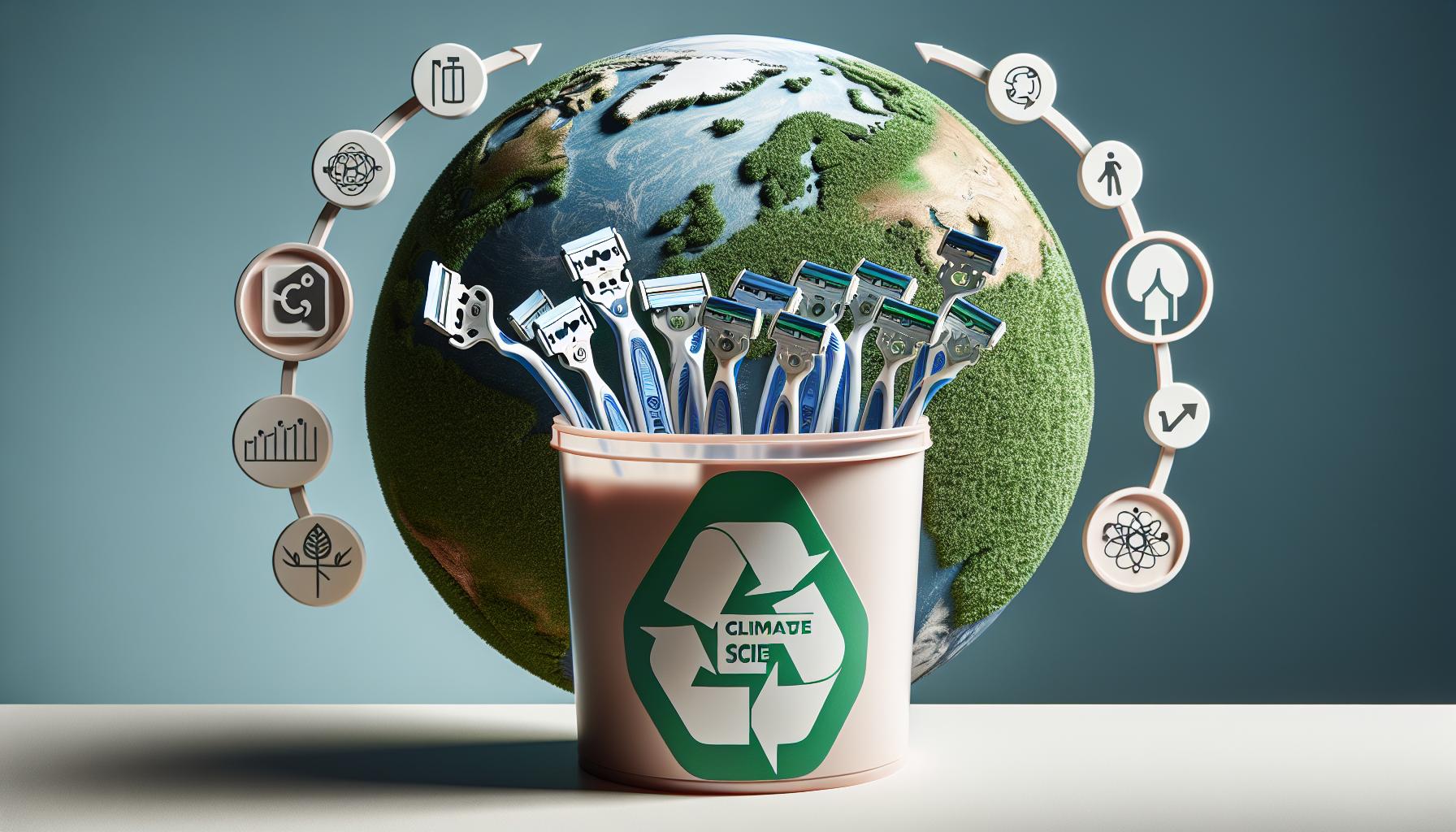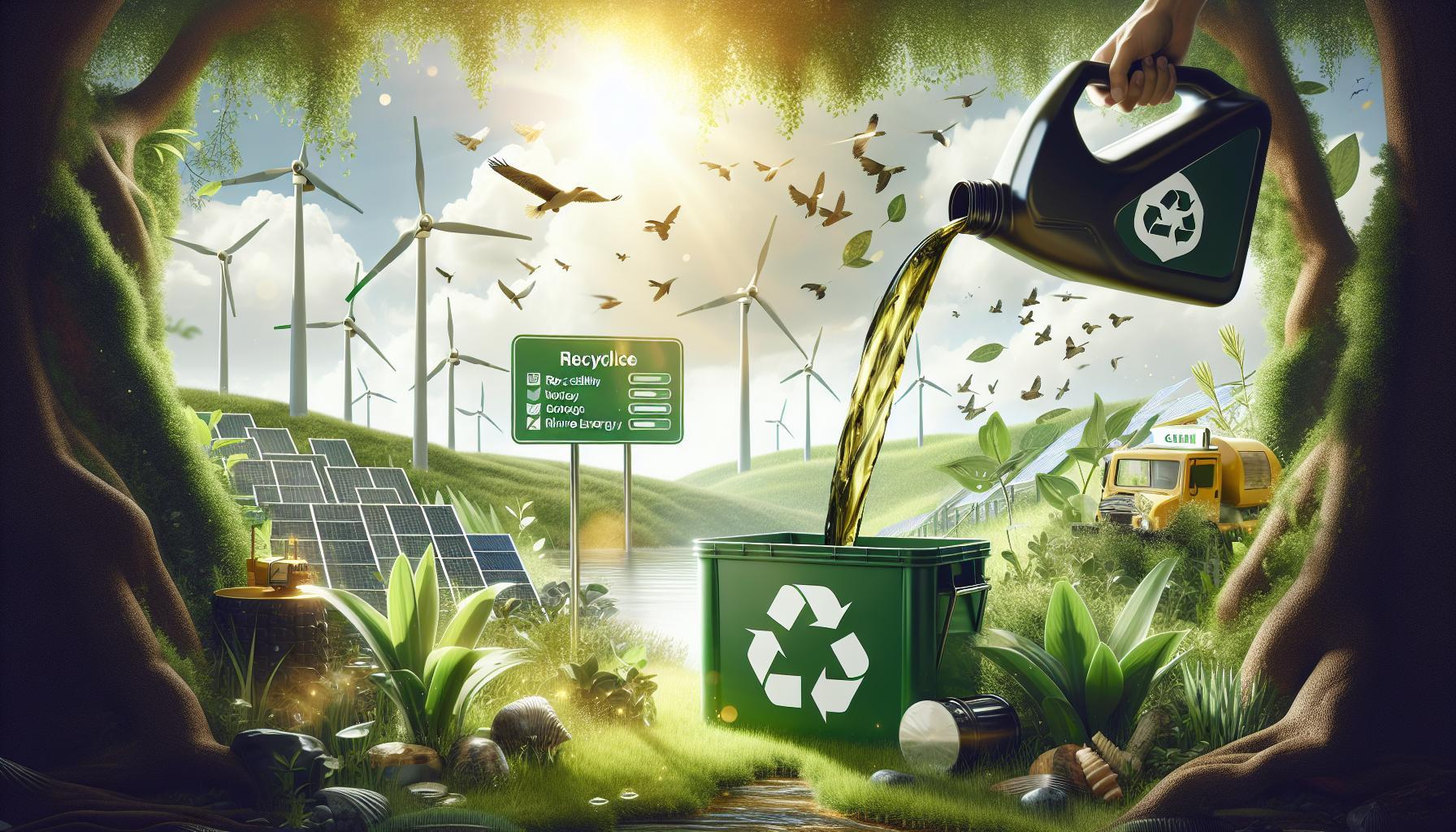Did you know that billions of razor blades end up in landfills each year, contributing to environmental pollution and posing safety risks for waste management workers? As increasing awareness about sustainability grows, finding ways to recycle these seemingly small yet impactful items is essential.
In this guide, we will explore effective methods for recycling your used razor blades, demonstrating that even simple changes in our daily routines can lead to significant positive outcomes for the planet. By understanding the importance of proper disposal and embracing eco-friendly practices, you can play a vital role in reducing waste and protecting our environment. Join us as we uncover practical tips and innovative solutions that not only help the planet but also resonate with your values of sustainability and responsible living.
Understanding the Environmental Impact of Razor Blades
The widespread use of razor blades, especially in disposable and cartridge razors, poses significant environmental challenges. Every year, billions of these metal and plastic products end up in landfills and oceans, contributing to pollution and waste accumulation. For instance, disposable razors largely consist of non-biodegradable plastics, which can take hundreds of years to decompose. This slow degradation not only adds to landfill mass but can also lead to microplastics entering the ecosystem and affecting marine and wildlife. Understanding this impact is crucial in fostering responsible consumer habits.
An essential aspect of minimizing environmental damage from razor blades is recognizing the difference between types of razors. Many traditional safety razors feature replaceable blades made from stainless steel, which are often recyclable. However, disposable razors are typically designed for one-time use and aren’t easily recycled, compounding their environmental footprint. Transitioning to reusable razors and responsibly recycling or disposing of used blades can significantly reduce waste. Moreover, many companies, like Albatross Designs and Gillette, are creating innovative recycling programs that allow users to return old razors and blades, facilitating responsible disposal and recycling processes that mitigate their environmental impact.
Incorporating sustainable practices into our shaving routines is not just beneficial for the planet but also empowers consumers to make a tangible difference. By opting for razors that emphasize recyclability and joining established recycling initiatives, individuals contribute to a circular economy where materials are kept in use for as long as possible and waste is minimized. This collective effort can lead to substantial reductions in the environmental burden associated with personal grooming. Ultimately, awareness and conscious choices in our daily life can pave the way for a more sustainable future regarding razor blade usage.
Why Recycling Razor Blades Is Essential for Sustainability
Every year, countless razor blades are discarded, contributing to significant environmental harm. These small yet formidable items, composed of metals and often encased in plastic, pose a unique challenge in waste management. The act of recycling razor blades is not merely a personal choice; it serves as a critical component in the broader quest for sustainability. As consumers become increasingly aware of their ecological footprint, understanding the importance of recycling these everyday items is essential for fostering responsible habits and mitigating the environmental impact associated with personal grooming.
Recycling razor blades reduces the volume of waste that ends up in landfills, where they can remain for hundreds of years without breaking down. Unlike biodegradable products, razor blades are often made from stainless steel, a material that is recyclable but frequently overlooked. By opting to recycle these blades, individuals help conserve valuable resources by allowing the material to be repurposed rather than mined anew. Furthermore, this process diminishes the demand for new raw materials, thereby lowering the carbon footprint associated with production.
To emphasize the point, various innovative recycling initiatives are emerging to facilitate this process. Companies like Gillette are partnering with TerraCycle to create dedicated recycling programs, making it easier for consumers to participate in responsible recycling efforts. Additionally, individuals can choose safety razors with recyclable blades, which significantly lessens the waste generated compared to disposable razors. Ultimately, recycling razor blades is not just about proper disposal; it reflects a commitment to a sustainable lifestyle and serves as an encouragement for others to reduce waste in their grooming practices. By taking action and participating in recycling efforts, consumers are contributing to a more sustainable future, proving that even small changes can lead to considerable positive impacts on the environment.
Safe Methods for Recycling Razor Blades at Home
Many individuals are unaware that there are safe and effective methods for recycling razor blades at home, yet this practice is crucial for minimizing environmental impact. Discarded blades pose a risk not only to landfill spaces but also to people who may come into contact with them. By engaging in responsible recycling, you contribute to sustainability while keeping your community safe.
One common method is to use a dedicated blade bank, which is a secure container designed for the safe storage of used razor blades. You can purchase these online, or if you’re inclined towards DIY solutions, creating one from an old metal soup can is an excellent alternative. Simply ensure that the lid is securely affixed after you place the blades inside. Once the container is full, you can follow your local guidelines for hazardous waste disposal, or if local options are available, prepare the container for recycling through specialized programs. It’s important to note that not all curbside recycling programs accept metal items, so check before placing the container in your bin.
Additionally, companies like Gillette offer convenient recycling programs. They allow consumers to mail in used blades and packaging by downloading a free shipping label, effectively ensuring that blades are recycled responsibly [2[2]. Furthermore, consider engaging with community or local initiatives that focus on recycling e-waste or hazardous materials, as these often include razor blades in their accepted items. This not only allows for proper recycling but also creates awareness and promotes collective action towards environmental responsibility in your community.
In adopting these safe recycling methods at home, not only do you contribute to reducing landfill waste, but you also become an active participant in the movement toward more sustainable consumer habits. This empowers you as a consumer and encourages others to examine their waste disposal practices, proving that even small actions can lead to significant environmental benefits.
How to Find Local Razor Blade Recycling Programs
Finding local recycling programs for razor blades may seem daunting, but it can significantly contribute to minimizing environmental waste. Many areas now offer dedicated facilities or programs designed specifically for the safe disposal of sharp objects like razor blades. Here’s how to locate these resources in your community and ensure that you’re doing your part for sustainable disposal.
Start by checking with your local waste management or sanitation department. Many cities have programs that accept hazardous materials, and typically razor blades fall under this category. You can visit their websites or call their offices for details on designated drop-off locations or scheduled collection days specifically for sharps, including razor blades. In addition, some states offer “Household Hazardous Waste” events where you can dispose of items safely.
Many recycling organizations, like TerraCycle, provide specific guidance on recycling razor blades through mail-in programs or drop-off centers. Companies associated with personal care products, including brands like Gillette, often have their own recycling initiatives where consumers can send back their used blades. Check their official websites or customer service sections for instructions and locations.
Finally, don’t underestimate the power of community platforms. Websites such as Facebook, Nextdoor, or local forums often have groups focused on recycling and sustainability. These can be excellent sources for discovering local initiatives where you can safely dispose of razor blades. Participating in community efforts not only helps you find a recycling program but also raises awareness about the importance of proper disposal among your neighbors.
By proactively seeking out and utilizing these resources, you not only ensure proper recycling of your razor blades but also contribute to a broader culture of sustainability within your community.
Innovative Solutions for Eco-Friendly Razor Blade Disposal
The journey towards sustainable living often begins with recognizing the impact of our everyday choices, and disposing of razor blades responsibly is no exception. One innovative solution involves utilizing specialized razor blade disposal containers. These are compact, safe, and designed to securely store used blades until they can be properly recycled. Many companies are now offering these containers as part of a comprehensive “safety razor” kit, promoting not just safety in disposal but also eco-conscious behaviors.
Another promising approach lies in community-based initiatives. Local organizations can team up with waste management facilities to create accessible drop-off points specifically for razor blades. These initiatives can raise awareness about the environmental issues associated with improper disposal and make it easier for individuals to participate in sustainable practices. For instance, schools or community centers can hold recycling drives that encourage residents to bring in used blades, creating a sense of collective responsibility towards environmental stewardship.
Partnerships with Manufacturers can also facilitate eco-friendly disposal. Many razor brands now collaborate with recycling firms to set up take-back programs. These programs often allow consumers to return used razor blades directly to the retailers or participate in mail-back services. This not only ensures safe disposal but can also motivate brands to develop more sustainable products over time. For example, brands like Gillette have established programs through TerraCycle that allow users to send back blades and packaging for recycling, emphasizing the role of manufacturers in supporting end-of-life solutions for their products.
Ultimately, embracing these innovative solutions can transform the way we view razor blade disposal. By actively seeking out safe and responsible methods, whether through dedicated disposal containers, community programs, or partnerships with producers, we can collectively work toward reducing waste and minimizing our environmental footprint. Together, these efforts highlight the opportunity for our daily habits to contribute to a more sustainable future.
Exploring the Best Eco-Conscious Razor Options
When it comes to choosing razors that minimize environmental impact, the options have evolved significantly with sustainability in mind. Traditional disposable razors contribute a staggering amount of plastic waste, as they are often used for just a few shaves before being thrown away. However, there are several eco-conscious alternatives that not only reduce waste but also enhance the shaving experience.
One of the top choices is the safety razor, which boasts a single replaceable blade, significantly cutting down on plastic waste. Unlike disposable options, safety razors can be used for years, as the handle is made from durable materials, often metal or wood, while the blades can be easily recycled. This method not only reduces the number of blades ending up in landfills but also encourages a more mindful and intentional shaving practice. Brands like Albatross Designs even offer recycling programs specifically for their blades, allowing consumers to send back used ones for proper processing.
Another innovative choice is the bamboo razor, which features a biodegradable handle and often utilizes stainless steel blades. Products like these combine functionality with a lower environmental footprint, as bamboo grows quickly and is often sourced sustainably. Furthermore, the aesthetic appeal of bamboo razors can add a touch of elegance to your grooming routine while contributing positively to the planet.
For those who prefer a more modern twist, consider razor subscription services that prioritize sustainability. Companies such as Billie and HARRY’S not only provide high-quality blades but also emphasize eco-friendly packaging and recycling efforts. These subscriptions often include information on how to recycle or return used blades, making it easy for consumers to participate in sustainable practices without hassle.
In summary, opting for safety razors, bamboo alternatives, and eco-friendly subscription services can significantly lessen one’s environmental impact. By making informed choices, consumers can contribute to a more sustainable ecosystem while enjoying a premium shaving experience that aligns with their values.
DIY Projects Using Old Razor Blades
Recycling razor blades isn’t just about what happens to them when they leave your bathroom; it can also spark creativity in your DIY projects. Instead of tossing old blades into the trash, consider repurposing them through innovative methods that both reduce waste and allow for artistic expression. Old razor blades, especially from safety razors, can be transformed into functional tools or art materials, giving them a second life while promoting sustainability.
One popular DIY project is creating miniature tools for model building or craft work. The sharp edge of a discarded blade can serve as an excellent cutting tool for precise cuts in paper, cardboard, or small plastic pieces. To make this DIY tool, carefully secure an old razor blade into a wooden handle or a stick using adhesive. Always prioritize safety by ensuring the blade is handled with care and properly secured to prevent accidents.
Another creative use for old razor blades is in upcycling jewelry or decorative art. For example, they can be incorporated into mixed media art or used to create unique jewelry pieces that feature a rustic or edgy aesthetic. With a little creativity, you can use them to form pendants, earrings, or even as accents in home decor projects. Ensure that any edges are smoothed out or enclosed to prevent injuries.
Finally, old blades can also play an essential role in gardening. They can be used as precision cutters for delicate stems or branches, especially in bonsai care or flower arrangements. By fashioning a small tool from old blades, gardeners can maintain the health and appearance of their plants while contributing to a more sustainable environment.
Ultimately, making the most of old razor blades in these innovative projects offers not only a waste reduction strategy, but it also allows individuals to engage in creative, meaningful activities. Embracing such practices reinforces the idea that sustainability is not just about recycling-it’s also about reimagining and repurposing materials in ways that inspire personal expression and environmental mindfulness.
The Importance of Properly Packaging Razor Blades for Recycling
Disposing of old razor blades might seem trivial, but improper packaging can lead to significant safety concerns during recycling. It’s essential to recognize that razor blades are sharp, potentially hazardous items. A simple oversight in their disposal can pose risks not only to waste management workers but also to the environment if they are scattered or misplaced. By taking the time to package these items correctly, you can contribute to a safer recycling process and ensure that these materials are handled responsibly.
When preparing razor blades for recycling, consider using a dedicated container-such as a small, sturdy box or a jar with a secure lid. These protective receptacles can minimize the risk of injury, preventing blades from cutting through bags or boxes during collection or transport. Proper labeling is also crucial; clearly marking the container as “razor blades” or “sharp items” communicates to anyone handling the waste that caution is necessary. This small act of diligence can make a significant difference in maintaining safety standards.
Once your container is full, you can seek out local recycling programs that accept these materials. Many facilities have specific guidelines for razor blade disposal, and by ensuring that your blades are securely packaged, you can help streamline their recycling process. It’s worth noting that some companies are now introducing dedicated recycling programs for razor blades and similar products. Participating in these initiatives not only supports environmental sustainability efforts but also serves as a model for others in your community.
Taking the right steps to package razor blades properly showcases a commitment to safety and sustainability. As individuals and communities prioritize environmental consciousness, even small actions can collectively lead to substantial change. Proper packaging reinforces the importance of responsible disposal practices, ultimately paving the way for innovative approaches in recycling and waste management. Your efforts can encourage others to be mindful of their environmental footprint and inspire a culture of sustainability within your community.
Addressing Misconceptions About Razor Blade Recycling
Misunderstandings surrounding the recycling of razor blades can hinder eco-friendly practices and lead to improper disposal methods that pose risks to both people and the environment. One major misconception is that all plastic items, including disposable razors and their blades, can be recycled in standard curbside bins. However, razor blades are considered hazardous due to their sharp edges and the materials they are made from, which require specialized recycling processes. Acknowledging this crucial distinction is the first step toward effective recycling.
Another common belief is that simply throwing razor blades in the trash is an acceptable disposal method. In reality, this practice can result in sharp items ending up in landfills, potentially injuring waste management workers and contributing to environmental pollution. To counter this, it is essential to educate individuals on the importance of using designated containers for old blades, which are specifically designed for safe disposal and recycling. Using a sturdy, labeled box can prevent injuries and ensure that the blades are sorted properly within recycling facilities.
As the conversation around sustainability grows, it’s also vital to highlight that recycling programs are becoming increasingly available. Many communities now offer specialized programs that cater to the recycling of razor blades, turning what was once seen as a common waste material into a valuable resource. Participating in these initiatives is a positive demonstration of commitment to environmental responsibility. Consumers can take action by seeking out local recycling centers that accept razor blades or by looking for manufacturers that offer mail-back recycling programs.
Lastly, embracing the notion that all actions matter empowers individuals to make a difference. Simple changes, such as opting for reusable razors or eco-friendly blade options, can collectively lead to significant reductions in waste. Each step taken toward proper recycling and disposal of razor blades not only protects workers and the environment but also contributes to a broader culture of sustainability. By dispelling myths and encouraging informed practices, we can foster a community that champions responsible waste management solutions.
Community Initiatives for Sustainable Razor Blade Disposal
Many communities are coming together to address the pressing issue of razor blade disposal through innovative initiatives that prioritize sustainability. These local efforts represent a powerful step towards reducing waste and educating residents about safe disposal methods. With razor blades often relegated to regular waste bins, community programs serve as essential platforms for raising awareness and providing accessible recycling options.
One effective approach adopted by numerous towns and cities is organizing recycle drive events. During these events, participants can safely drop off their used razor blades at designated collection points. These drives not only facilitate the proper disposal of hazardous items but also create an opportunity for community engagement. Residents can learn about the environmental impact of improper disposal and how their actions contribute to a larger sustainable effort. Collaborations with local environmental organizations or schools can enhance participation and community outreach.
Additionally, some cities are establishing permanent collection stations specifically for razor blades. These stations, often located in places like community centers, pharmacies, or recycling facilities, provide easily accessible options for residents. They serve as a continuous resource for safe disposal, reinforcing the message that responsible waste management is part of a broader community commitment to sustainability. Moreover, these initiatives can be promoted through social media and local advertisements, encouraging more people to participate in eco-friendly practices.
Furthermore, educational campaigns are instrumental in changing public perceptions about razor blade recycling. Workshops and online resources can be developed to inform residents about the hazards associated with standard trash disposal and the benefits of recycling razor blades. By empowering individuals with knowledge and practical steps for safe disposal, these community initiatives not only improve local environments but also foster a culture of responsibility and awareness that extends beyond razor blades to other types of waste.
Encouragingly, as more communities adopt such initiatives, they create a ripple effect, inspiring neighboring areas to implement similar programs. Collective action rooted in local engagement demonstrates that each person’s effort, when combined, can lead to substantial positive environmental change.
Future Trends in Razor Blade Recycling and Upcycling
As society seeks to become more sustainable, the demand for innovative solutions to manage waste, including razor blade disposal, is rising. This presents an opportunity not only for manufacturers but also for individuals to engage in eco-friendly practices that minimize environmental harm. In this evolving landscape, trends in razor blade recycling and upcycling are paving the way for practical solutions that reduce waste while encouraging creative reuse.
One of the most promising trends is the increasing development of specialized recycling programs tailored specifically for razor blades. These programs often partner with local municipalities and recycling facilities, ensuring that used razor blades are collected and processed appropriately. Companies are also beginning to innovate with recycling in mind, designing razor disposal systems or containers that safely hold used blades until they can be recycled. This systematic approach encourages consumers to rethink their disposal habits and promotes a culture of responsible waste management.
Additionally, upcycling initiatives are gaining traction as creative individuals and communities explore ways to transform used razor blades into functional or artistic items. DIY projects range from creating art pieces and home decor to developing tools for gardening and crafts. Such projects not only divert waste from landfills but also empower individuals to take action against environmental issues in a personal and meaningful way. Community workshops focused on these creative pursuits can serve as both educational and engagement opportunities, fostering teamwork while highlighting the potential of recycling and upcycling.
Educational Outreach and Awareness
An essential component of these future trends is the role of education in raising awareness about the importance of proper disposal and recycling. Schools, local governments, and community organizations can collaborate to create educational campaigns that inform the public about eco-friendly practices related to razor blade disposal. This can involve interactive online platforms, workshops, and hands-on activities, making the learning process engaging and relevant to various age groups. Such initiatives not only share knowledge but also inspire community-wide action towards sustainability.
In summary, the future of razor blade recycling and upcycling is not just about managing waste; it is about fostering a cultural shift towards sustainability. As communities adopt these innovative solutions, individuals are empowered to make a difference in their own lives while contributing to a larger environmental movement. Embracing these trends can lead to significant reductions in waste and inspire others to follow suit, ultimately creating a positive ripple effect in the quest for a more sustainable future.
Empowering Personal Action: How You Can Make a Difference
Taking conscious steps towards eco-friendly razor blade disposal can significantly contribute to reducing the overall impact of personal grooming on the environment. With millions of razor blades discarded each year, every individual’s action counts. By adopting sustainable practices, you not only prevent hazardous waste from ending up in landfills but also inspire those around you to consider their waste management habits.
One straightforward way to begin making a difference is to utilize designated blade disposal containers. These systems are designed to safely hold used razor blades until they can be properly recycled. Many communities are establishing drop-off points for hair salons and barbershops, where customers can contribute their used blades, ensuring they do not end up in regular trash. If such facilities exist in your area, take advantage of them. If not, consider suggesting the idea to local businesses or community groups, promoting a culture of responsible waste disposal.
Additionally, consider switching to more sustainable razor options. Reusable safety razors are not just better for the environment; they can also save you money in the long run. When using a standard razor, take advantage of manufacturers’ take-back programs, which allow you to send old blades back for safe recycling. Research which brands offer these services and encourage friends and family to follow suit. Sharing experiences about eco-friendly products can create a ripple effect, encouraging more individuals to prioritize sustainability in their grooming routines.
Lastly, actively engage in community initiatives focused on recycling and waste reduction. Participate in local clean-up days or educational workshops that discuss proper razor blade disposal methods. By involving yourself in these initiatives, you not only boost your eco-credentials but also raise awareness about the importance of proper disposal among peers. Engaging in conversations, sharing knowledge online, and leading by example can empower others to take similar actions in their pursuit of sustainability, creating a network of informed and proactive individuals working towards a healthier planet.
Faq
Q: How can I recycle razor blades safely?
A: To recycle razor blades safely, store them in a dedicated sharps container or a sturdy, sealed container. Once full, check for local hazardous waste programs that accept them. Many recycling centers have designated drop-off days specifically for sharp objects.
Q: Why is it important to recycle razor blades?
A: Recycling razor blades reduces landfill waste and promotes environmental sustainability. Proper disposal prevents injuries in landfills and allows the steel to be repurposed, thereby conserving resources.
Q: Are there eco-friendly alternatives to traditional razor blades?
A: Yes, consider using safety razors or straight razors. These opciones minimize waste, as they use replaceable blades instead of disposable cartridges. Additionally, brands now offer stainless steel blades that can be recycled more easily.
Q: Can you put used razor blades in regular recycling?
A: No, used razor blades should not be placed in regular recycling bins due to injury risks. They are classified as hazardous waste; therefore, proper disposal methods must be followed to ensure safety for sanitation workers and the environment.
Q: What materials can razor blades be recycled into?
A: Razor blades are typically made from stainless steel, which can be melted down and repurposed into new products, such as construction materials or new metal items. Recycling helps minimize resource extraction.
Q: How can I find a local program for recycling razor blades?
A: To find local programs, check your city’s waste management website or use services like Earth911.com to search for nearby facilities that accept razor blades and other sharps for proper disposal.
Q: What are the environmental impacts of improperly disposed razor blades?
A: Improperly disposed razor blades can harm wildlife and contribute to landfill injuries. They also pose a risk of cuts and infections for sanitation workers, emphasizing the need for responsible disposal methods.
Q: How should I store used razor blades before recycling?
A: Store used razor blades in a rigid, sealed container, such as an empty pill bottle or a specialized sharp container. This prevents accidental injury and ensures they are safe to transport to a recycling facility.
Key Takeaways
As you embark on your journey to recycle razor blades responsibly, remember that each small action contributes to a healthier planet. Transitioning to sustainable options like safety razors can significantly reduce plastic waste, making a positive impact on our environment. Don’t wait-take the leap today by choosing eco-friendly razor alternatives and implementing proper recycling practices.
For additional insights on sustainable grooming, explore our articles on reducing plastic waste in your bathroom routine and the benefits of zero-waste alternatives. Plus, don’t forget to sign up for our newsletter for expert tips and resources that empower you to live sustainably. Your commitment to recycling razor blades not only helps prevent landfill overflow but also inspires others in your community to make eco-conscious choices. Join the movement for a greener future and make your voice count!





